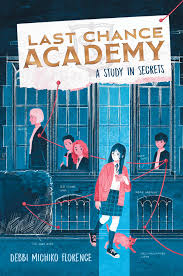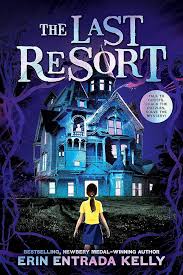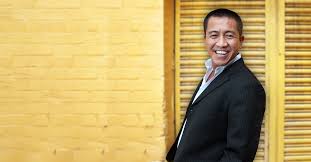If you haven’t heard of Anh Do, it’s for one reason, and one reason only: you haven’t spent time in Australia. There, he’s a beloved TV personality, stand-up comic, artist, memoirist, and yes… bestselling children’s author. His wildly popular Wolf Girl series, which features Gwen, a plucky, slingshot-toting tween and her pack of furry and feathery friends, has sold over a million copies Down Under.
The second installment in the series, The Great Escape, is now available in the U.S. from Harper, along with Book 1, Into the Wild, which came out last year.
But first…
The Great Escape: A Summary
After spending four years alone in the wild, Gwen is overjoyed to see another human being. But all that changes when she’s thrown into the back of a van and taken to a remote prison camp. The situation looks dire. How will her pack of loyal animal friends find her? Where are her parents and sister? Are the other kids in the camp friends or enemies? And, above all, how will she escape?
And now, without further ado…
ANH DO!
MR: Welcome to the Mixed-Up Files, Anh! It’s an absolute pleasure to have you here!
AD: Thank you, Melissa. It’s a real joy to be here!
MR: Although American readers may not be familiar with the Wolf Girl series, the books have sold more than a million copies in Australia. What’s the secret to writing a series with such strong reader appeal? It’s no mean feat, especially in today’s competitive market.
AD: I have a super short attention span, which was a problem when I was a kid, sitting in class. But now it’s my superpower. My books have to be fascinating to me, first and foremost, so my children’s books have truckloads of awesome things that happen. Every few pages there is something amazing, or moving, or surprising, or funny. I guess this keeps my readers totally engaged and delighted.
Anh’s Inspiration
MR: What was your inspiration for the series, and for your plucky protagonist, Gwen? She’s quite a force of nature.
AD: When I was a kid, my family owned a farm. We had seven dogs that helped keep foxes at bay and look after the other animals. They became like my little band of buddies. I spent entire days wandering around the forest with my pack of dogs.
About 30 years later, I was watching my three-year-old daughter, sitting with her soft toys and talking to her fluffy dog toys, when suddenly the idea of Wolf Girl popped into my head: a little girl who gets lost in the forest and befriends a wolf puppy and a bunch of adorable dogs. Over the years they become family, and the dogs teach her how to become more in tune with her senses and how to detect danger, the way dogs do. Some people have said that Wolf Girl is a bit like Tarzan but with dogs instead of apes, and a young girl instead of a muscle-bound man.
Kindness in the Face of Adversity
MR: In The Great Escape, Gwen is taken to a prison camp, where children are forced to work as unpaid laborers. There, she meets Rupert, a fellow inmate who shows compassion to Gwen by sneaking her food. What were you trying to say about the nature of kindness, particularly in the face of adversity?
AD: I think human beings are innately kind. Of course there are exceptions, but whenever you see a natural disaster, like a hurricane or fire, people will help other people who are total strangers. I have found that in my childhood. I grew up very poor and was raised by a single mum. Many people, young and old, helped me and I wouldn’t be where I am today if it wasn’t for their kindness.
Animal Friends
MR: Gwen shares the spotlight with a pack of heroic animal friends: a wolf, four dogs, and an eagle who serve as her protectors. As Gwen says, “If not for my animals, I don’t know if I would have survived.” Can you elaborate?
AD: Gwen is about eight years old when she befriends the lost animals and they become her family. The dogs and eagle help her hunt for food and provide her with warmth when she curls up amongst them. But they also provide her with emotional comfort. The animals mean that she is not totally alone.
Vietnam to Australia
MR: While we’re on the subject of survival, your 2010 memoir, The Happiest Refugee, chronicles your family’s perilous journey by boat from war-torn Vietnam to Sydney, Australia. How did that experience shape you as a writer and influence your books?
AD: Yes, I am a refugee and my family lived through the Vietnam war. In fact, my father and uncles fought alongside American soldiers, so I grew up with stories told at the dinner table every night. Every story was life and death, kindness and betrayal, love and loss and danger. All these things are now deeply infused in my books.
Renaissance Man
MR: Switching gears, I think it’s fair to say that you’re the true definition of a Renaissance man. Not only have you written dozens of books for children and adults, but you’re also a stand-up comic, an actor, an artist, and have even competed on Dancing with the Stars! Is there anything you’re not good at, Anh?
AD: I can’t swim. Tried loads of times but I sink really quick!
MR: As a follow-up, with so many things going on in your life—including a multi-city comedy tour—how do you juggle it all?
AD: I love everything I do, so it doesn’t feel like work. It feels like pursuing a hobby. When something stops feeling like fun, I drop it pretty quick; otherwise it will sap my energy.
MR: Rumor has it that Wolf Girl is being adapted into a film, with actress Rose Byrne as the producer. Can you tell us more? Also, will you be in it? 🙂
AD: I can’t tell you too much, except to say that I am super excited about Wolf Girl as well as many of my other titles being turned into TV or film adaptations!
Anh’s Writing Routine
MR: What does your writing routine look like, Anh? Do you have a particular time during the day when you prefer to write? Any habits or rituals?
AD: I write everywhere, on planes, in taxis, even whilst shopping. If an idea pops into my head when I’m shopping, I stop and type the idea into my phone to capture the idea before it flies off with the wind. I was once in a gift store and I saw a statue of the three monkeys who are blocking their eyes, ears. and mouth. You might’ve seen this kind of statue before. Suddenly an idea popped into my head: imagine a trio of villains called ‘Senseless’ who can walk into a bank and make everyone in the bank momentarily lose their sight, hearing, and verbal ability? Wouldn’t that be a scary trio of villains? So they are now the main villains in my series Skydragon.
The Secret Cave
MR: The final book in the Wolf Girl trilogy, The Secret Cave, is coming out in March 2026. Can you give readers of taste of what’s to come? (No spoilers, of course! 🙂)
AD: The Secret Cave has an Indiana Jones kind of adventure vibe. By the way, Book 3 is not the final Wolf Girl book. In Australia, Wolf Girl is up to 14! The series is a sweeping tale told over many years and there is heartbreak and family reunions and betrayal and love and loss and everything in between!
MR: What are you working on now, Anh?
AD: Another 100 books. I’ve released over 100 books in Australia. Now for the next hundred.
Lightning Round!
MR: And finally, no MUF interview is complete without a lightning round, so…
Preferred writing snack? Nuts
Coffee or tea? Coffee
Superpower? Laughter
Best piece of writing advice? Do whatever it takes to get really, really good.
Favorite joke? Why is 6 scared of 7? Because 789.
Favorite place on earth? Tuscany
If you were stranded on a desert island with only three things, what would they be? A nice yacht, a helicopter, and a submarine
MR: Thank you for chatting with me, Anh—and congratulations on the publication of The Great Escape. I can’t wait to read book #3, when it comes out next year!
AD: Thank you, Melissa. It’s been so much fun!

Melissa Roske is a writer of middle-grade fiction. Before spending her days with imaginary people, she interviewed real ones as a journalist in Europe. In London she landed a job as an advice columnist for Just Seventeen magazine. Upon returning to her native New York, Melissa contributed to several books and magazines, selected jokes for Reader’s Digest (just the funny ones), and received certification as a life coach. In addition to her debut novel Kat Greene Comes Clean (Charlesbridge), Melissa’s short story “Grandma Merle’s Last Wish” appears in the Jewish middle-grade anthology, Coming of Age: 13 B’Nai Mitzvah Stories (Albert Whitman). Learn more about Melissa on her Website and follow her on Facebook and Instagram.



























